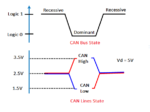Texas Instruments has introduced new semiconductors designed to improve automotive safety and intelligence. The AWR2544 77GHz millimeter-wave radar sensor chip is the industry’s first for satellite radar architectures, enabling higher levels of autonomy by improving sensor fusion and decision-making in ADAS. TI’s new software-programmable driver chips, the DRV3946-Q1 integrated contactor driver and DRV3901-Q1 integrated squib […]
texasinstrumentsinc
IoT: Microcontrollers and sensors must work as a team
Get an understanding of how to select sensors and microcontrollers for your IoT product, with an emphasis on circuit design to optimize performance. Sensors in IoT devices collect data from the environment, after which the data can be processed and analyzed to make intelligent decisions. The quality of your sensors and how well you integrate […]
Current sensors and current shunt monitors for common-mode voltages and temperatures
Texas Instruments debuted new current sensors to help engineers simplify their designs while improving accuracy. Designed for a broad range of common-mode voltages and temperatures, the new products include a lowest-drift isolated Hall-effect current sensor for high-voltage systems and a portfolio of current shunt monitors that eliminate the need for an external shunt resistor for […]
What are top applications of CAN protocol?
The CAN (controller area network) protocol was developed by the European automotive electronics company Robert Bosch GmbH in 1983 for in-vehicle networks. The intention behind the development of the CAN protocol was to enable robust data communication between different electronic control units (ECU) and microcontroller control units (MCU) of a vehicle on a single wire […]
5G mmWave signal chain: the phase-locked loop
In “Look inside the 5G mmWave signal chain,” we explored the overall architecture of the mmWave signal chain. Now, we’ll look deeper into each of a transceiver’s components. Phase-locked Loops (PLL) are important blocks for a clean reference clock generation in cellular networks. In 5G mmWave radio networks, the PLL supports data rates of 1…
Introducing a SimpleLink family of Wi-Fi 6 companion integrated circuits
Texas Instruments introduced a new SimpleLink™ family of Wi-Fi 6 companion integrated circuits (ICs) to help designers implement highly reliable, secure, and efficient Wi-Fi connections at an affordable price for applications that operate in high-density or high-temperature environments up to 105ºC. The first products in TI’s new CC33xx family include devices for Wi-Fi 6 only […]
Teardown: Amazon 4th generation Echo Dot
One of the latest incarnations of the Echo Dot boasts premium sound and an ability to pair up with Fire TV devices for a home theater audio experience. Construction-wise, there are usually a few changes from one generation of Echo devices to the next, and sometimes between early and later models of the same generation. […]
Power supply ICs come in rad-hard plastic packages
Texas Instruments announced an expansion in its portfolio of space-grade analog semiconductor products in highly reliable plastic packages for a diverse range of missions. TI developed a new device screening specification called space high-grade in plastic (SHP) for radiation-hardened products and introduced new analog-to-digital converters (ADCs) that meet the SHP qualification. TI also introduced new […]
Matter-enabled dev kits work with SimpleLink wireless MCUs
Texas Instruments (TI) has introduced new Matter-enabled software development kits for Wi-Fi and Thread SimpleLink wireless microcontrollers (MCUs) that will streamline adoption of the Matter protocol in Internet of Things (IoT) applications. The software builds on TI’s close involvement with the Connectivity Standards Alliance and innovation in the 2.4-GHz connectivity space. Engineers can use the new software […]
APIs added to online ordering for real-time inventory information
Semiconductor supply assurance continues to be a priority in the electronics industry. Texas Instruments announced a step forward to help manufacturers get the products they need, introducing a suite of application programming interfaces (APIs) that provide unprecedented access to accurate, real-time inventory information about available TI analog and embedded processing products. “Companies are looking for […]











